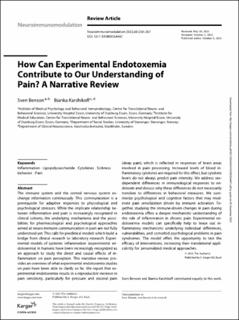| dc.contributor.author | Benson, Sven | |
| dc.contributor.author | Karshikoff, Bianka | |
| dc.date.accessioned | 2023-12-07T12:42:42Z | |
| dc.date.available | 2023-12-07T12:42:42Z | |
| dc.date.created | 2023-12-05T12:41:45Z | |
| dc.date.issued | 2023 | |
| dc.identifier.citation | Benson, S., & Karshikoff, B. (2023). How can experimental endotoxemia contribute to our understanding of pain? A narrative review. Neuroimmunomodulation, 30(1), 250-267. | en_US |
| dc.identifier.issn | 1021-7401 | |
| dc.identifier.uri | https://hdl.handle.net/11250/3106414 | |
| dc.description.abstract | The immune system and the central nervous system exchange information continuously. This communication is a prerequisite for adaptive responses to physiological and psychological stressors. While the implicate relationship between inflammation and pain is increasingly recognized in clinical cohorts, the underlying mechanisms and the possibilities for pharmacological and psychological approaches aimed at neuro-immune communication in pain are not fully understood yet. This calls for preclinical models which build a bridge from clinical research to laboratory research. Experimental models of systemic inflammation (experimental endotoxemia) in humans have been increasingly recognized as an approach to study the direct and causal effects of inflammation on pain perception. This narrative review provides an overview of what experimental endotoxemia studies on pain have been able to clarify so far. We report that experimental endotoxemia results in a reproducible increase in pain sensitivity, particularly for pressure and visceral pain (deep pain), which is reflected in responses of brain areas involved in pain processing. Increased levels of blood inflammatory cytokines are required for this effect, but cytokine levels do not always predict pain intensity. We address sex-dependent differences in immunological responses to endotoxin and discuss why these differences do not necessarily translate to differences in behavioral measures. We summarize psychological and cognitive factors that may moderate pain sensitization driven by immune activation. Together, studying the immune-driven changes in pain during endotoxemia offers a deeper mechanistic understanding of the role of inflammation in chronic pain. Experimental endotoxemia models can specifically help to tease out inflammatory mechanisms underlying individual differences, vulnerabilities, and comorbid psychological problems in pain syndromes. The model offers the opportunity to test the efficacy of interventions, increasing their translational applicability for personalized medical approaches. | en_US |
| dc.language.iso | eng | en_US |
| dc.publisher | Karger International | en_US |
| dc.rights | Navngivelse 4.0 Internasjonal | * |
| dc.rights.uri | http://creativecommons.org/licenses/by/4.0/deed.no | * |
| dc.title | How Can Experimental Endotoxemia Contribute to Our Understanding of Pain? A Narrative Review | en_US |
| dc.type | Peer reviewed | en_US |
| dc.type | Journal article | en_US |
| dc.description.version | publishedVersion | en_US |
| dc.rights.holder | © The Author(s) 2023 | en_US |
| dc.subject.nsi | VDP::Medisinske Fag: 700 | en_US |
| dc.source.pagenumber | 250-267 | en_US |
| dc.source.volume | 30 | en_US |
| dc.source.journal | Neuroimmunomodulation | en_US |
| dc.identifier.doi | 10.1159/000534467 | |
| dc.identifier.cristin | 2209147 | |
| cristin.ispublished | true | |
| cristin.fulltext | original | |
| cristin.qualitycode | 1 | |

